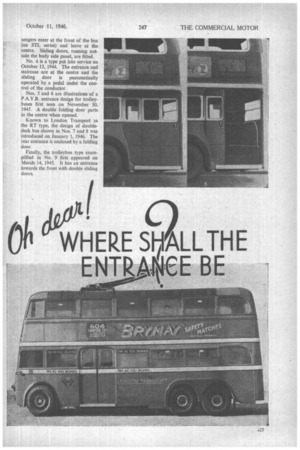L OCATION a n d layout o entrances o n public-service
Page 28

Page 29

If you've noticed an error in this article please click here to report it so we can fix it.
vehicles influence: (a) The maintenance of running schedules on urban services, particularly at peak periods; (b) the facility with which fares may be collected; (c) the safety of passengers in boarding and alighting from buses; and (d) the practicability of employing the driver in the additional role of conductor Many engineers and managers have their own ideas on entrance design, and we shall be pleased to receive them. Meanwhile, we illustrate on these pages some enlight• riled experiments made during the past two years by London Transport in its search for the ideal design foi a pay-as-you-board bus Finality has not yet been reached and the Board declines to comment on its experiments until they approach conclusion.
Illustrations 1, 2 and 3 show a payas-you-board type introduced on October 24, 1945, in which the entrance and exit are separate Pas. sengers enter at the front of the bus (an STL series) and leave at the Centre. Sliding doors, running outside the body side panel, are fitted.
No. 4 is a type put into service on October 13, 1944. The entrance and staircase are at the centre and the sliding door is pneumatically operated by a pedal under the control of the conductor.
Nos. 5 and 6 are illustrations of a P.A.Y.B. entrance design for trolleybuses first seen on November 30, 1945. A double folding door parts in the centre when opened.
Known to London Transport as the RT type, the design of doubledeck bus shown in Nos. 7 and 8 was introduced on January 1, 1946. The rear entrance is enclosed by a folding door.
Finally, the trolleybus type exemplified in No. 9 first appeared on March 14, 1945. It has an entrance towards the front with double sliding doors.




































































